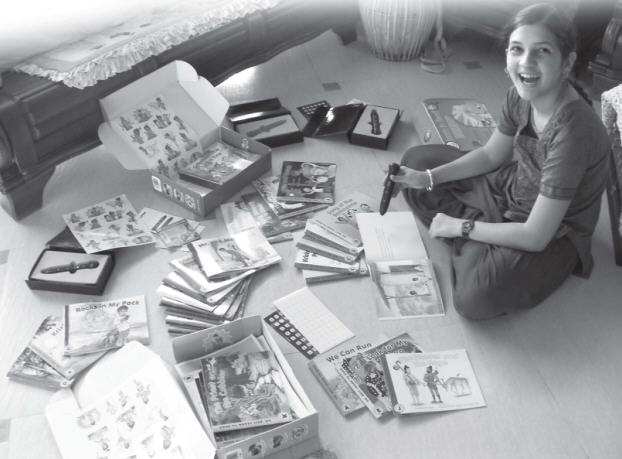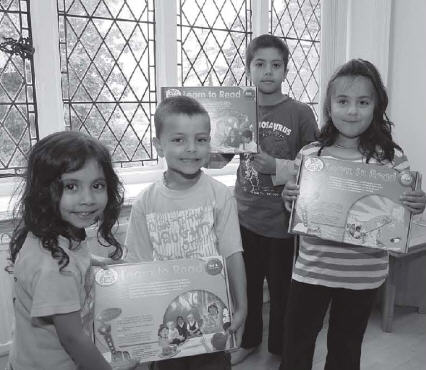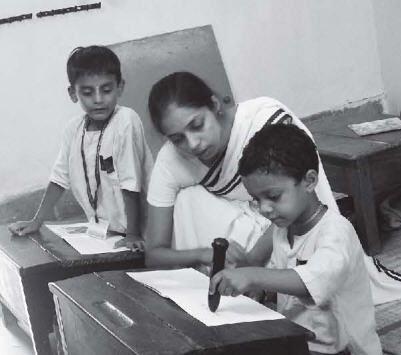Touch a page of these Krishna stories and they speak in
English, Hindi, Bengali, Telugu, and 20 other languages!
We are what we think, feel, and desire. Our thoughts in life and at the time of death create our body and life circumstances. Change our mind, change our life. Material thoughts and desires give us material bodies and karma, whereas spiritual thoughts and desires get us our original pure spiritual consciousness. And when are our thoughts most easily formed? In the Gita the answer is, “from the very beginning of life.”
Where is Our Ancient Wisdom?
In the holy city of Mayapur, school children crowded around, ready to read. “Look at that!” one boy said jumping from his place. “The boys in this book are vegetarian!” Although the children in this class live in a Krishna-saturated environment, in order to learn how to read they had to use books filled with materialistic messages. Until now.
In Belgium, a six-year-old girl who learned French in school learned English with her mother. The mother explained how difficult it is to raise a child with spiritual values. It’s painful, she said, to have to sacrifice the values we want to teach our children, in order to give them an excellent academic education. Why not be able to do both? Now, there seemed to be a way.
In Australia, Sri Prahlad grew up in the Hare Krishna Movement in the 70’s and 80’s. For his academic education, his teachers had to use books and materials opposed to spiritual values. He told me that he longed for learning books that would also speak to his heart.
What Values are Taught in Modern Learn-to-Read Texts?

In 2007, devotee teachers gathered dozens of reading systems from top publishers. We expected to find patterns of materialist propaganda in the books. But I had never looked at so many books from so many authors and companies. Even so, I was surprised by the specifics of the underlying messages and themes, molding children’s thoughts and desires.
You might guess what was portrayed, over and over, as an ideal life. It was all middle-class families. Most of them lived in suburbs. The few rural families didn’t farm with oxen. Most books also showed broken families as an alternative ideal. Not only was religion in general absent, but no books showed renunciates at all.
I did expect to see success shown as a secular, middle-class family, but I was unprepared for a very different pattern in non-fiction stories of animals. In all cases except where the prey was an insect, the prey animal would escape from the predator. Children readers were clearly expected to identify with the prey, seeing the predator as a dangerous enemy. Yet, they consistently showed non-vegetarian food in stories of humans. Such hypocritical and unnatural treatment of meat-eating opposing it in carnivorous animals but accepting it as normal in humans was pervading.
We can see that these books teach much more than how to turn symbols into speech and meaning. They teach a particular perspective on life along with socially accepted identities that have corresponding actions and mindsets. Is the solution a valueless, thoughtless, desireless series of stories? Or perhaps we would look for educational materials where the ideal presented in one story directly conflicts with that of another. The first idea, the so-called neutral program, is impossible. In the Gita (12.5) such a course is described as against the nature of the soul and prevents love for God. In terms of reading books, reading instruction must involve reading something, and that something must have a message.
As to the second alternative, publishers use a consistent message, since children tend to see the world as orderly. And, the consistent message in learn-to-read books is materialistic.
Therefore, if a school or parent would like children to value vegetarianism, reincarnation, simple living, spiritual life, and love for Krishna, there was no “learn to read” program that would support those ideals? Prabhupada wrote in 1970: “What one learns as child is not lost throughout the life. So this [producing children’s educational books] is a very important business. Please execute it with great care and seriousness of purpose.” Would there finally be a solution?
Speaking Stories: An Alternative at Last

Starting in 2007, a few devotees interested in education decided to produce something revolutionary in a reading program. Three years and an international team of 200 people later, a London publisher produced the resultant system of 83 books with three “MagicPens.”
When he saw the books, Sri Prahlad wrote, “The stories in these books bring tears to my eyes with their sweetness and devotion, food for my soul, spiritual and moral instruction and creative mental imagery to my mind, with their beautiful colorful pictures. They systematically develop the child’s reading skills teaching children to read at higher levels. I wish I had had books like this to engage and instruct me when I was a child growing up in the Hare Krishna movement. Knowing that future generations of Krishna kids will have access to this wonderful resource makes me happy.”
The new book series is being used for social change in Vrindavana, India. There, in two schools one for children who are the poorest of the poor and another for children of privilege children are getting a message of caring for cows humanely and celebrating traditional festivals in ecologically supportive ways, along with the philosophy and stories of their own Krishna conscious culture. Within two months of starting to learn English with the new series of books, children and teachers were talking more about serving Vrindavana than about becoming wealthy engineers.
Seeing the success of these books reminds us of how Prabhupada wrote in several different letters in the late 60’s and early 70’s: “It is good to note that you are writing these children’s books to comply with the academic standards of the public schools… if you can illustrate these books with pictures they will certainly become very, very popular in the [government] schools. ..… you can write many books for children and insert pictures, then they will be a sure success…. Therefore do this work very carefully to explain simply and directly Who is Krishna, who we are, what is the material world, what is the relationship of Krishna with the living entities, how we should act in that relationship, etc. And if you can illustrate these books with pictures they will certainly become very, very popular in the schools.”
“Give me more of those books!”
Now I sit with two of my grandchildren and teach them reading from the new books. If we take a day off they beg for reading class, and they are learning so quickly I am astonished. When we finish a class, they take the word lists and study on their own, creating their own sentences and their own books. They look for the words they are learning in any other print they can find throughout the day. It’s hard to end class each day. It is interesting to see that they are both learning easily and in their own style. The program naturally adjusts to them with no effort on my part. My daughter-in-law and I notice them talking about the stories. “Most stories in early learn-to-read books are so boring, no one wants to read them,” I comment to her.
Hearing our discussion, my 13-year-old grandson calls out from his room, “The stories are so much fun, I like to read them myself!” It is common for me to get letters saying that older children or adults are having so much fun with the books that the children for whom they were purchased have to beg to read them.
What’s Magical about These Textbooks?
I taught hundreds of children how to read during about three decades of being a teacher, but children didn’t like reading class this much. Is it the spiritual content? The fact that even the beginning stories have a real plot? The fact that many illustrations are done by devotees who are professional animators? The variety of illustrations from international artists? The fact that the series can support varieties of teaching techniques, even though some proponents of each claim these methods cannot be reconciled? The fact that 2 of the top 5 literacy experts in the world gave book-by-book guidance? The fact that the pages talk in 25 languages and the pictures speak?
Books that talk? How did that happen? In 2009, I learned about a new technology that would embed audio files into ordinary paper using nearly invisible dots. Our books would be able to talk with the touch of a special pen-like device. We decided to have each page of text speak in 25 languages. The characters in the pictures would also talk, adding conversational English and songs beyond the text. Children and teachers could also record their voices into the pages. No other “learn to read” book in the world had such features.
Our publisher told us, “Have devotees of Krishna do the recording, rather than professional actors who are not devotees. The mood comes through the voice, and you want people who love the stories.” His advice now shines from every page as the characters in the 500 pieces of original artwork speak to the young readers.
Worldwide Appreciation

When I was in Tirupati and Chennai in South India, local devotees took me to meet leaders in education in the Sri-sampradaya, in the disciplic line from Ramanujacharya. They are astounded to see their beloved stories and values in a series that uses the most scientific teaching methods. And they were thrilled to hear the books speak in their own languages of Telugu, Tamil, and Kannada as much as the North Indians enjoyed the Hindi, Bengali, and Gujarati, or the European devotees were amazed to hear Spanish, French, Russian, and Croatian come from otherwise ordinary paper.
Children who are not Indian, not Hindu, not devotees of Krishna, and not even vegetarian or interested in reincarnation are also enchanted with the “magical” books. We received this letter from the staff at a secular government school in Wales, UK, “We would like to thank you for the wonderful books you gave us for the children. They have enjoyed using them. We feel very fortunate to have been given the opportunity to enjoy these stories.”
The Hare Krishna Movement is now the first among all the top publishers of the world to have a learn-to-read series that speaks in twenty-five languages. We are also the first to have a series that can be used with whole language or two kinds of phonics. We are the first to have a reading series that promotes India’s spiritual values while at the same time meeting professional educational standards. But the greatest satisfaction is being part of a program that pleases the Lord and His pure devotees, who want to see as many people as possible molding their hearts and minds towards spiritual perfection.
To know more about these books or order them, visit:
http://talkingpen.in/www.illuminationeducation.com/home
http://blservices.com/books/children-books/dr-best-urmila-dd
Urmila Devi Dasi, a disciple of Srila Prabhupada, is an associate editor of the International Back to Godhead magazine. She has a Ph. D in Education with three decades of teaching experience. Urmila and her husband are in the vanaprastha order. They have three married children and ten grandchildren.
